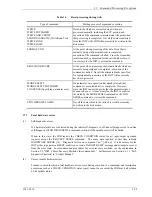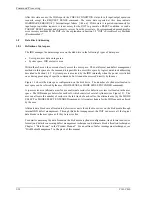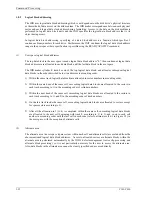
Data Buffer Management
2-2
C141-C010
Segment 7
Segment 6
Segment 5
Segment 4
←
Read
←
Read
Write
→
Segment 3
Segment 2
Segment 1
Segment 0
Valid Data
Write
→
Disk Media
INIT
Segment
Figure 2.1
Data buffer configuration (in the case of 8 cache segments)
The basic functions and operations of the data buffer in a read operation and a write operation are shown
below.
(1) Read
operation
Data read from the disk media are temporarily stored in the data buffer. Then, they are transferred to the
SCSI bus with the timing specified in the MODE SELECT parameter. The basic read operation
procedure is as shown below.
1) When the IDD receives a command, normally, it disconnects from the SCSI bus through disconnect
processing and locates the data block specified by the command where it is stored on the disk media.
2) When the target data block has been located, the IDD reads the data form the disk media to the data
buffer. At this time, if a recoverable error is detected, the IDD performs error recovery processing
according to the specification in the MODE SELECT parameter or corrects the data in the data
buffer.
3) When the IDD has read the amount of data specified by the buffer full ratio in the MODE SELECT
parameter (see Section 2.1.2) to the data buffer, it performs reconnection processing with the SCSI
bus and begins transferring data to the INIT (SCSI bus) from the data buffer while continuing to read
subsequent data blocks to the data buffer.
4) If the data transfer capacity of the INIT (SCSI bus) is high and the data buffer becomes empty before
completing transfer of the number of data blocks specified by the command, the IDD performs
disconnect processing at that point. Thereafter, reconnection, data transfer and disconnection (the
operations in 3) and 4) above) are repeated until all the data blocks specified in the command have
been transferred.
5) If the number of blocks specified in the command to be transferred is larger than the capacity of a
cache segment and if the data transfer rate of the INIT is lower than the data transfer rate of the disk
drive, the empty space in the data buffer disappears from step 3) and the IDD may soon not be able
to read data from the disk media (data overrun). In this case, the IDD relocates the block that caused
the data overrun after waiting one disk revolution, and continues the reading process.
Summary of Contents for 80
Page 4: ...This page is intentionally left blank ...
Page 10: ...This page is intentionally left blank ...
Page 18: ...This page is intentionally left blank ...
Page 62: ...This page is intentionally left blank ...
Page 284: ...Sense Data Error Recovery Methods This page is intentionally left blank ...
Page 296: ...This page is intentionally left blank ...
Page 298: ...This page is intentionally left blank ...
Page 308: ...This page is intentionally left blank ...
Page 309: ......
Page 310: ......
















































